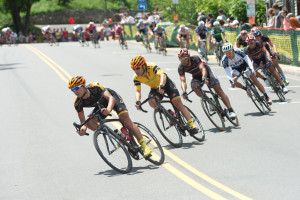 Get FREE SPEED and learn how to corner. Cornering a bike properly can save you massive amounts of energy and time. I have been working on cornering every ride since my last race… where I got destroyed on the downhill. So… what was I doing wrong?
Get FREE SPEED and learn how to corner. Cornering a bike properly can save you massive amounts of energy and time. I have been working on cornering every ride since my last race… where I got destroyed on the downhill. So… what was I doing wrong?
Look Where You Want to Go
Your body likes to follow your eyes, so look where you want to go, not where you don’t. A common mistake is continuing to look at what you are trying to avoid; this generally results in a collision with that same object. Let your peripheral vision do the work, it can see that object and you will not hit it.
Look far in to the corner, not right in front of you. Your hips turn the same direction you are looking and your hips determine where the bike is going to steer. I am guilty of looking directly in front of myself quite frequently, especially when the turns come hard and fast. Depending on your speed and the angle of the corner determines how far in to the corner you look. In sharp corners look as far ahead as possible. Play with it and you will notice significant improvements immediately.
Brake Before the Corner
 I am aggressive when it comes to cornering, too aggressive. I loose valuable speed because I do not brake enough before the turn which results in me having to brake in the turn. Braking in the turn actually makes the bike want to stand up on itself and straighten out, two things you are trying not to do. You end up fighting the bike and shedding more speed than necessary to make the turn safely.
I am aggressive when it comes to cornering, too aggressive. I loose valuable speed because I do not brake enough before the turn which results in me having to brake in the turn. Braking in the turn actually makes the bike want to stand up on itself and straighten out, two things you are trying not to do. You end up fighting the bike and shedding more speed than necessary to make the turn safely.
Generally, you only want to be doing one of the following things at any given time: braking, cornering, or pedaling. Combining these things can lead to disaster.
Find the Line
Approach the corner as wide as possible, cut through the apex and finish wide. This is the straightest line through the turn, allowing you to carry more speed and reducing the angle of the turn making it less scary. Many people cut to the apex to early which results in excessive braking near the end of the turn and exiting slowly.
Don’t Pedal in a Corner Pedal out of a Corner
Pedaling in a corner can cause you to strike your inside pedal on the ground and send you flying. If this happens try not to panic and over correct. Over correcting will certainly cause a crash.
Once you have completed the turn and the bike is in a more upright position it is safe to hammer on the pedals again. Hopefully you remembered to shift down to an easier gear before you entered the turn so it is not too difficult to pedal out of it.
How to Steer Your Bike
There are three different ways to steer the bike: Upright steering, leaning and countersteering.
Upright Steering
Upright steering is when you turn your handle bars and keep your body and the bike as upright as possible. This is best reserved for slow speeds and dangerous conditions i.e. wet and slippery conditions. If your tried this at a high speed you would fly off your bike. Been there, done that… don’t recommend it.
Leaning
This is the most common method of steering and involves leaning your bike and body over to make the turn. Lean over more to turn sharper and make sure that you have your outside pedal at the 6 o’clock position pushing your weight through that pedal to keep traction with your tires.
Countersteering
The next level of steering. In order to test it out, go down a straight road, pick up some speed then push your right hand down… what happens? Initially your front wheel turns right, but as the bike starts to lean over you turn left. The sharper the turn and less consistent the turn (more bends) the more important countersteering becomes.
Position While Countersteering
Initially, you press with your opposite hand, but as you being to turn you want your inside arm straight and applying a bit of pressure to continue to turn the direction you want to go.
Lean your body over, but then lean your bike over even harder. This is not like leaning technique where the angle of your bike and the angle of your body are the same in relation to the ground. In countersteering you lean the bike over more and your body is more upright in order to keep traction.
Try to keep your weight back and low and remember to push hard on your outside pedal that is located at the 6 o’clock position.
If you learn how to countersteer you will not regret it, it is safer and faster as it allows you to make adjustments through out the turn much quicker.
